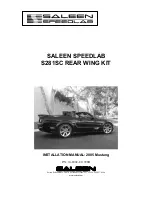
Using the TIREFIT kit
X
Do not remove any foreign objects which have
penetrated the tyre, e.g. screws or nails.
X
Remove the tyre sealant bottle, the accom-
panying TIREFIT sticker and the tyre inflation
compressor from the stowage space under
the boot floor (
Y
page 305).
X
Affix part
:
of the TIREFIT sticker to the
instrument cluster within the driver's field of
vision.
X
Affix part
;
of the TIREFIT sticker near the
valve on the wheel with the defective tyre.
X
Pull plug
?
with the cable and hose
A
out of
the tyre inflation compressor housing.
X
Screw hose
A
onto flange
B
of tyre sealant
bottle
:
.
X
Place tyre sealant bottle
:
head downwards
into recess
;
of the tyre inflation compres-
sor.
X
Remove the cap from valve
C
on the faulty
tyre.
X
Screw filler hose
D
onto valve
C
.
X
Insert plug
?
into a 12 V socket (
Y
page 280)
in your vehicle.
X
Turn the key to position 1 in the ignition lock
(
Y
page 139).
X
Press on and off switch
=
on the tyre inflation
compressor to I.
The tyre inflation compressor is switched on.
The tyre is inflated.
First, tyre sealant is pumped into the tyre. The
pressure may briefly rise to approximately
500 kPa (5 bar/73 psi).
Do not switch off the tyre inflation com-
pressor during this phase.
X
Let the tyre inflation compressor run for a
maximum of five minutes. The tyre should
then have attained a pressure of at least
180 kPa (1.8 bar/26 psi).
If a pressure of 180 kPa (1.8 bar/26 psi) has
been attained after five minutes, see "Tyre pres-
sure reached" (
Y
page 309).
If a tyre pressure of 180 kPa (1.8 bar/26 psi) has
not been attained after five minutes, see "Tyre
pressure not reached" (
Y
page 309).
If tyre sealant leaks out, make sure you clean the
affected area as quickly as possible. It is pref-
erable to use clear water.
If you get tyre sealant on your clothing, have it
cleaned as soon as possible with perchloroethy-
lene.
308
Flat tyre
Breakd
own
assist
ance
















































